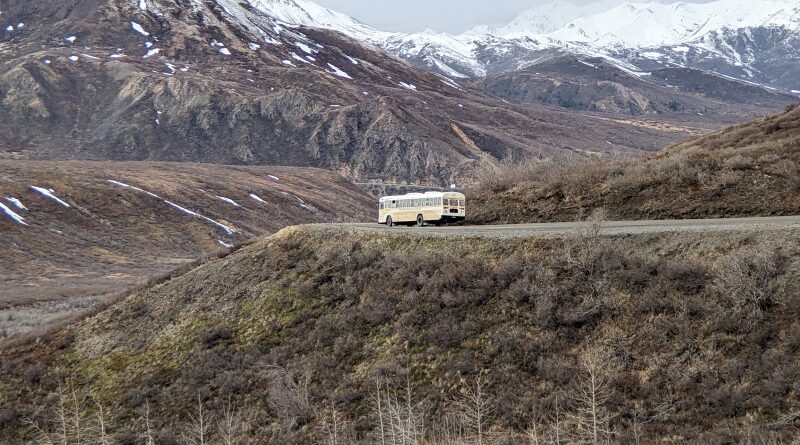Climate Change and the Park Road

Part 2 of a Series – see Series Introduction here
“I want you to act as you would in a crisis, I want you to act as if the house is on fire, because it is.” – Greta Thunberg
At our recent annual DCC membership meeting, the panel discussion reflected on many nostalgic memories of the way things used to be in Denali National Park. Fun stories were shared, mention was made of the changes in vegetation, the impact of too many buses on the road, a decrease of bird sightings, the “Wilderness Character” of the gravel road and challenges of maintaining a gravel road versus a paved road. There were references to the Pretty Rocks “Slump” and the proposed bridge that would span the slide and allow the business of the National Park to proceed as it was before climate change threw a big wrench into the works.
The “big wrench” of course, is the thawing of the underlying structure of the road, which has accelerated the slump and caused panic for the industrial tourism industry. Denali National Park has become part of the economic engine for the cruise ship industry and their associated land-based excursions. Most summer visitors are brought to Denali courtesy of several large tourism corporations. The ships are like small cities with the accompanying waste and pollution, meanwhile advertising the pristine beauty of Alaska. Most of the ships run on the cheapest oil to maximize profit and discharge sewage and exhaust into the pristine waters and air along the coast of Alaska.
Climate change is constantly in the news about heat domes, drying forests, larger fires, longer fire seasons, droughts, intense storms and flooding, smoky skies, higher sea levels and dire warnings from the experts that study climate. We have Paris Accords, Kyoto Accords, COP 18, 21, and 26. All in agreement that if we don’t act to change our current system, then its game over. The park makes a big deal about their recycling program, discussions about using “eco-friendlier” vehicles and “last one out of the building turn off the lights” signs, etc. But is this their answer to the existential issue of climate change? The carbon footprint of building the bridge over Polychrome is staggering. The cost has shot up from $25 million to $130 million. Change orders will be issued and taxpayers will pay. The bridge goes forward, all it takes is lots of taxpayer dollars and lots of climate denial. Socialize the cost and privatize the profit.
Think of the good the National Park Service could do with that money – a resource agency with the marching orders to protect lands “unimpaired for future generations”. Meanwhile, without maintenance of the road beyond Polychrome, much degradation will take place. Gravel will be mined, hauled and placed, compacted, and treated for dust abatement. The Eielson Visitor Center needs a roof replacement, melting and slumping is happening in numerous places along the road, on and on it goes. The old tourism model for Denali simply needs to be abandoned. This road has served its purpose superbly for 90 years. The world has changed dramatically in the meantime. The consequences of doing this bridge is not justified. I am certain the wildlife on the west end of the park is doing just fine, almost as if the idea of “preserving unimpaired the natural and cultural resources and values of the national park system….” could be accomplished without the road.
This should be an opportunity for the NPS to lead by example, showing how to accommodate the changes brought by climate change by not building this bridge. So far, the road seems to successfully accommodate visitors to the East Fork River at mile 43. Evidently many passengers are content with this. They get to see the beautiful Sable Pass and a peek of the wilderness beyond. Perhaps they are sufficiently inspired and appreciate the acknowledgement that this is enough, let the wild be wild.
Nan Eagleson is a long-time Alaskan naturalist and guide. She has served on the DCC board of directors for over two decades.



100% agree, Nan! I just can’t fathom spending that much money on a project that benefits so few (mostly very wealthy) people when the rest of the park system has such great needs. There are places in the Lower 48 where you have to get a ticket to go on a hike. We should use this money where people actually live and help regular people get access to nature.
Sounds about right to me, Nan. I think we were very lucky to avoid catastrophe the last few seasons of PC. I had a few moments of “we really shouldn’t be doing this!”
While I love and agree with Scott Richardson’s sentiments, I feel a bridge should not be built. Now we must acknowledge that the world is undergoing serious destructive rapid change and we must do ALL in our power to reduce this climate crisis.
Nan Eagleson brings up many excellent points concerning tourism, the failing road and Denali. I totally agree with her. We should not be encouraging people to fly or travel in huge polluting ships. The problems she mentions are real.
“Let the wild be wild.” Please Park Service be part of real solutions!!!
I completely agree with everything Nan said so concisely and accurately. We need people, especially decision makers, to acknowledge the actual reality of the situation on the park road – that we are living in a new era now that requires new, productive, reality based thinking. Initially I thought that there was no way the NPS would go ahead with that absurd plan of trying to build a bridge across continually slumping ground – and it’s appalling to me that they are just throwing immense amounts of money away to primarily placate the cruise ship tourism industry, and to continue the reckless delusion that humans can “control” nature in that way. It seems evident that no one in the park service has the wherewithal to actually make the decision to stop this fantasy of “repairing and rebuilding” the park road, so it’s going to take the strong efforts of concerned citizens to stop this, and to create a new vision of how humans interact with Denali Natl. Park.